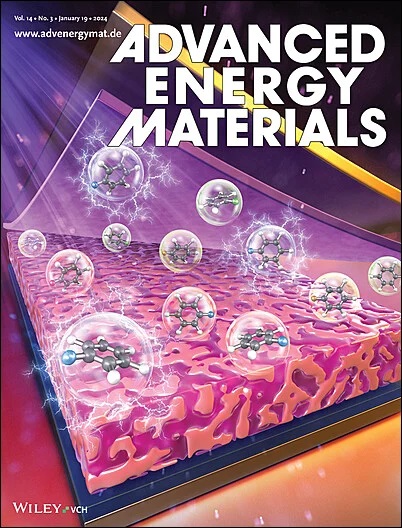Zn2+ Mediator with Ultrahigh Capacity over 8 m Enabled by H1.07Ti1.73O4 Ion Sieve for Stable Zinc Metal Batteries
IF 24.4
1区 材料科学
Q1 CHEMISTRY, PHYSICAL
引用次数: 0
Abstract
Interfacial engineering is universally acknowledged as a dependable methodology to address the aqueous zinc metal interface issues. Although it is quite effective, the introduction of a modification layer impedes interfacial ion transport kinetics to some extent. Addressing this trade-off between stability and ion flux is critical for advancing zinc-based energy storage systems. Herein, a layered titanate (H1.07Ti1.73O4, HTO) medium layer enabling fast Zn2+ transport and ultrahigh Zn2+ concentration on the zinc anode surface is proposed. It is demonstrated that HTO uniquely facilitates Zn2+ enrichment through the exchange of interlayer H+ ions, achieving an exceptionally high Zn2+ adsorption concentration of 8.35 m, far exceeding that of electrolyte (2 m ZnSO4). The HTO layer serves as a dynamic ion transport bridge, establishing a continuous conductive pathway, and its inherent negative charge to selectively block sulfate anion (SO42−) penetration, thus exhibiting dual functionality as an ion conductor and anion sieve. The protected anode (Zn@HTO) exhibits exceptional stability, achieving nearly 2300 h cycling stability at a current density of 0.5 mA cm−2 and over 3900 h at 5 mA cm−2. Furthermore, Zn@HTO//ZnVO full cell demonstrates prolonged operational stability. This strategy provides a significant stride in breaking through the limitation of electrolyte concentration, thereby enabling fast, stable electrochemical reactions.

界面工程被公认为是解决锌金属水界面问题的可靠方法。虽然这种方法相当有效,但改性层的引入会在一定程度上阻碍界面离子传输动力学。解决稳定性和离子通量之间的权衡问题对于锌基储能系统的发展至关重要。本文提出了一种层状钛酸盐(H1.07Ti1.73O4,HTO)介质层,可在锌阳极表面实现快速 Zn2+ 传输和超高 Zn2+ 浓度。研究表明,HTO 通过层间 H+ 离子交换独特地促进了 Zn2+ 的富集,实现了 8.35 m 的超高 Zn2+ 吸附浓度,远远超过了电解质(2 m ZnSO4)的吸附浓度。HTO 层可作为动态离子传输桥梁,建立连续的导电通道,其固有的负电荷可选择性地阻止硫酸根阴离子(SO42-)的渗透,因此具有离子导体和阴离子筛网的双重功能。受保护的阳极(Zn@HTO)表现出卓越的稳定性,在电流密度为 0.5 mA cm-2 时可实现近 2300 小时的循环稳定性,在电流密度为 5 mA cm-2 时可实现超过 3900 小时的循环稳定性。此外,Zn@HTO//ZnVO 全电池还表现出长期的运行稳定性。这一策略在突破电解质浓度限制方面取得了重大进展,从而实现了快速、稳定的电化学反应。
本文章由计算机程序翻译,如有差异,请以英文原文为准。
求助全文
约1分钟内获得全文
求助全文
来源期刊

Advanced Energy Materials
CHEMISTRY, PHYSICAL-ENERGY & FUELS
CiteScore
41.90
自引率
4.00%
发文量
889
审稿时长
1.4 months
期刊介绍:
Established in 2011, Advanced Energy Materials is an international, interdisciplinary, English-language journal that focuses on materials used in energy harvesting, conversion, and storage. It is regarded as a top-quality journal alongside Advanced Materials, Advanced Functional Materials, and Small.
With a 2022 Impact Factor of 27.8, Advanced Energy Materials is considered a prime source for the best energy-related research. The journal covers a wide range of topics in energy-related research, including organic and inorganic photovoltaics, batteries and supercapacitors, fuel cells, hydrogen generation and storage, thermoelectrics, water splitting and photocatalysis, solar fuels and thermosolar power, magnetocalorics, and piezoelectronics.
The readership of Advanced Energy Materials includes materials scientists, chemists, physicists, and engineers in both academia and industry. The journal is indexed in various databases and collections, such as Advanced Technologies & Aerospace Database, FIZ Karlsruhe, INSPEC (IET), Science Citation Index Expanded, Technology Collection, and Web of Science, among others.
 求助内容:
求助内容: 应助结果提醒方式:
应助结果提醒方式:


